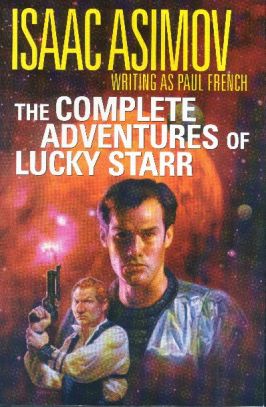I haven’t bought any new SF books in ages now, but, with Christmas behind me and a few quid spare in my pocket, I took the notion over the past couple of weeks to trawl Ebay.co.uk for some books. Actually, none of them are “new”, as there’s not a lot of modern SF that I enjoy, with the exception of some anthologies of short fiction and a very narrow range of authors and sub-genres. But I did find two second hand/used anthologies of classic Golden Age stuff, which is much more my kind of thing, one collection of Isaac Asimov’s fantasy stories, essays and articles, and, finally, one “Best of the Year” SF anthology, from 2007.
- SCIENCE FICTION: THE BEST OF THE YEAR 2007 EDITION edited by Rich Horton (trade paperback, Prime Books, Germantown MD, US, 2007, ISBN-10: 0-8095-6297-9, ISBN-13: 978-0-8095-6297-8)
- MAGIC: THE FINAL FANTASY COLLECTION by Isaac Asimov (Paperback, Voyager, London, 1997, ISBN: 0-00-648203-1)
- GREAT TALES OF THE GOLDEN AGE OF SCIENCE FICTION edited by Isaac Asimov, Charles G. Waugh and Martin H. Greenberg (hardback, Galahad Books, New York, 1991, ISBN: 0-88365-772-4)
- THE GOLDEN AGE OF SCIENCE FICTION edited by Kingsley Amis (Large Format Paperback, Penguin Books, 1983, first published by Hutchinson & Co., 1981)
The SCIENCE FICTION: THE BEST OF THE YEAR 2007 EDITION trade paperback is a nice anthology of reasonably recent (less than ten years old) stories, twelve in all, five from Asimov’s SF Magazine, two from F&SF, and the other five from five different sources both magazines and books. I haven’t read this one yet, but there are a few authors in it that I usually like (Robert Reed, Walter Jon Williams, Ian Watson, Robert Charles Wilson), and Rich Horton rarely puts together a bad “Best SF” anthology.
MAGIC: THE FINAL FANTASY COLLECTION is a single-author collection of Isaac Asimov’s fantasy (as opposed to SF) short fiction. It’s also notable for collecting a number of Asimov’s essays and articles about fantasy and other subjects. It’s a bit of a strange one, this, although I found it an interesting mix of articles and fiction. And Asimov’s fantasy is just as logical as his science fiction, with its own strict internal rules and limitations, which made it easy for me to read, despite the fact that I’m not a huge fan of reading fantasy.
GREAT TALES OF THE GOLDEN AGE OF SCIENCE FICTION is a cracking anthology of classic Golden Age SF put together by the ever-reliable trio of Isaac Asimov, Charles G. Waugh and Martin H. Greenberg. Nine stories in all, almost all of them published in Astounding during the 1941-1947 timeframe. Some of the biggest names in SF are in this one – Isaac Asimov, A.E. van Vogt, Jack Williamson, Theodore Sturgeon, Lester del Rey, C.L. Moore, Ross Rocklynne, A. Bertram Chandler, T.L. Sherred – and with some of their most classic stories.
THE GOLDEN AGE OF SCIENCE FICTION edited by Kingsley Amis is another cracking anthology, with a completely different group of stories and authors to the previous anthology. Only Asimov appears in both, but with different stories. And there are seventeen stories in this one, almost twice as many as the other anthology. Aside from Isaac Asimov, we’ve got Arthur C. Clarke, Poul Anderson, Frederik Pohl, Brian W. Aldiss, Cordwainer Smith, H. Beam Piper, Harry Harrison, Damon Knight, Anthony Boucher, James Blish, Robert Sheckley, J.G. Ballard, Kurt Vonnegut Jr., Jerome Bixby, F.L. Wallace and Philip Latham. That is a hugely impressive line-up of SF author talent with some of their most classic stories.
The Kingsley Amis anthology is a completely different kind of book to the other one edited by Asimov, Waugh and Greenberg. I wouldn’t really consider it a real “Golden Age” anthology at all, as the stories are from the 1950s and 1960s (there’s even one from 1979!), rather than the 1940s (the actual “Golden Age of SF” is usually considered to be circa 1938-1950, when Campbell’s Astounding ruled the roost unchallenged, and before the appearance of F&SF and Galaxy). The stories are therefore slightly more sophisticated than those in the other book, with much less of an emphasis on stories from Astounding, and a much higher percentage coming from F&SF, Galaxy and other sources. The stories are of the highest calibre, and the only criticism I would have is none of them actually qualify as “Golden Age” SF, as they come from a later period, and there are several of the 1960s stories that even come dangerously close to belonging to the New Wave. I guess Amis’ interpretation of “Golden Age” SF is a bit different to the rest of us, and maybe a bit more of a personal one. 🙂
All in all, a nice little batch of books. I’ve gotten the bug back again for hunting down SF books. I must get back on Ebay to see if I can find a few more classic anthologies.


